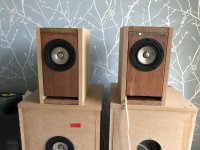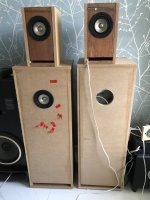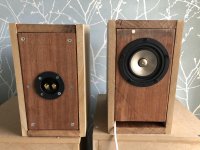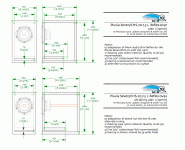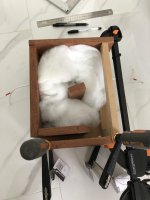Here is my expert (amateur) take on building the set of MA Pluvia7 bookshelf speakers.
These were hand crafted in a clean and sterile environment using only a Circular saw with an eyeball to guide each precision cut, which results in unique panels, so unique that in same speaker no panels are of equal to any other panel and each have their own characteristics, simply put no panels are of the same size on either of these cabinets.
Both speakers were created with their own method. One cabinet has the finesse and art to it that can only be achieved with slow, meticulous and ignorant method of clamps and glue. Whereas the second cabinet features the ruggedness and strength of screws and a power drill. You could say a 18v power drill resides in its heart as a result. Combined both of these in a pair results in meticulous sound that can never be replicated again.
Each cabinet wall has their own story to tell. The baffle, rear, top and bottom is the result of leftover cement covered hardwood from two year old construction site that was left and neglected overtime in the roof by the experts of roof construction. However, this results in a very favourable position as the width of this wood is an exact width required as per the construction plan. The side walls are another matter and required a journey in these troubled times to venture out and procure from very large establishment, there it lay in its deep slumber and was yanked from the shelf and was taken out to have it butchered.
Here, I present the creation of not so beautifully hand crafted Pluvia7 in its full glory in a tiny form. However, be warned and do not let its tiny form fool you for it is just as heavy and rough as a burning log in deep forest.
Now, you must have an irresistible urge to know, how do they perform?
I have one word for it.
Abysmal.
These were hand crafted in a clean and sterile environment using only a Circular saw with an eyeball to guide each precision cut, which results in unique panels, so unique that in same speaker no panels are of equal to any other panel and each have their own characteristics, simply put no panels are of the same size on either of these cabinets.
Both speakers were created with their own method. One cabinet has the finesse and art to it that can only be achieved with slow, meticulous and ignorant method of clamps and glue. Whereas the second cabinet features the ruggedness and strength of screws and a power drill. You could say a 18v power drill resides in its heart as a result. Combined both of these in a pair results in meticulous sound that can never be replicated again.
Each cabinet wall has their own story to tell. The baffle, rear, top and bottom is the result of leftover cement covered hardwood from two year old construction site that was left and neglected overtime in the roof by the experts of roof construction. However, this results in a very favourable position as the width of this wood is an exact width required as per the construction plan. The side walls are another matter and required a journey in these troubled times to venture out and procure from very large establishment, there it lay in its deep slumber and was yanked from the shelf and was taken out to have it butchered.
Here, I present the creation of not so beautifully hand crafted Pluvia7 in its full glory in a tiny form. However, be warned and do not let its tiny form fool you for it is just as heavy and rough as a burning log in deep forest.
Now, you must have an irresistible urge to know, how do they perform?
I have one word for it.
Abysmal.
Attachments
-
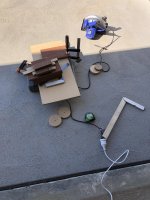 IMG_4885.jpg984.6 KB · Views: 588
IMG_4885.jpg984.6 KB · Views: 588 -
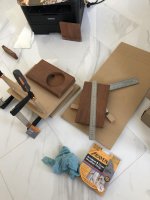 IMG_4886.jpg390.5 KB · Views: 544
IMG_4886.jpg390.5 KB · Views: 544 -
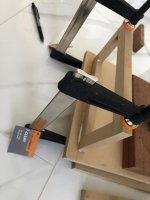 IMG_4887.jpg313.9 KB · Views: 558
IMG_4887.jpg313.9 KB · Views: 558 -
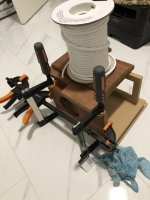 IMG_4888.jpg434.6 KB · Views: 560
IMG_4888.jpg434.6 KB · Views: 560 -
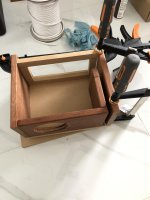 IMG_4889.jpg433.9 KB · Views: 551
IMG_4889.jpg433.9 KB · Views: 551 -
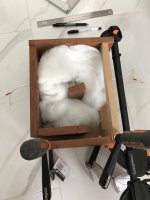 IMG_4890.jpg372 KB · Views: 268
IMG_4890.jpg372 KB · Views: 268 -
 IMG_4891.jpg659.6 KB · Views: 242
IMG_4891.jpg659.6 KB · Views: 242 -
 IMG_4892.jpg448.7 KB · Views: 280
IMG_4892.jpg448.7 KB · Views: 280 -
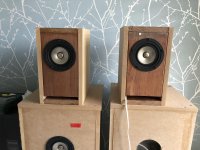 IMG_4893.jpg829 KB · Views: 356
IMG_4893.jpg829 KB · Views: 356 -
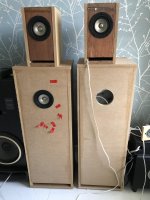 IMG_4894.jpg553.5 KB · Views: 349
IMG_4894.jpg553.5 KB · Views: 349
Hey Dave,
These are based on your Bass reflex design.
Unfortunately, my Home theatre amp had an issue and is under warranty repair and I had to swap my stereo amp to home theatre room. So, I have not been able to truly play these in stereo.
Actually I have not been able to play the bipole MLTL that I did earlier, so thats why I built these in meanwhile since they were just sitting there.
I am currently using Ikea symfonisk hack to drive one of these for a test, this requires tweeter and woofer to be separate, thats why I have separate tweeter that you can see in one of those photos on top of one cabinet.
One speaker being driven by ikea and separate tweeter is quite good, the tweeter adds really open soundstage and is very present. Obviously bass is little less than those bipole MLTL but it is sufficient, actually rather lot for its size. And with Ikea's trueplay, it really improves the sound.
I only built these yesterday, so have not had the chance to fine tune the stuffing and get a better prospectives.
These are based on your Bass reflex design.
Unfortunately, my Home theatre amp had an issue and is under warranty repair and I had to swap my stereo amp to home theatre room. So, I have not been able to truly play these in stereo.
Actually I have not been able to play the bipole MLTL that I did earlier, so thats why I built these in meanwhile since they were just sitting there.
I am currently using Ikea symfonisk hack to drive one of these for a test, this requires tweeter and woofer to be separate, thats why I have separate tweeter that you can see in one of those photos on top of one cabinet.
One speaker being driven by ikea and separate tweeter is quite good, the tweeter adds really open soundstage and is very present. Obviously bass is little less than those bipole MLTL but it is sufficient, actually rather lot for its size. And with Ikea's trueplay, it really improves the sound.
I only built these yesterday, so have not had the chance to fine tune the stuffing and get a better prospectives.
Last edited by a moderator:
I suspected.
Hope you amp is fixable and doesn’t require an arm & a leg.
Like many of my designs i have not heard these so am very intereste din end use impressions.
dave
Hope you amp is fixable and doesn’t require an arm & a leg.
Like many of my designs i have not heard these so am very intereste din end use impressions.
dave
hmm... sounds like I have port chuffing issue with these.
As per the plan the port height should be 12mm with 132mm in length.
One of my cabinet has 17mm height and other is at 13mm. The one with 13mm close to the original plan has this issue more prominent, the with 17mm also has this issue but not as prominent as the other.
It is straight edge port no rounded corners or edge.
When I removed the back to adjust the stuffing, the port chuffing noise went away. so it is definitely chuffing.
Not sure what to do here.
As per the plan the port height should be 12mm with 132mm in length.
One of my cabinet has 17mm height and other is at 13mm. The one with 13mm close to the original plan has this issue more prominent, the with 17mm also has this issue but not as prominent as the other.
It is straight edge port no rounded corners or edge.
When I removed the back to adjust the stuffing, the port chuffing noise went away. so it is definitely chuffing.
Not sure what to do here.
Attachments
I suspected.
Hope you amp is fixable and doesn’t require an arm & a leg.
Oh! it is under warranty so I am not worried about the cost. However, it has been out for almost 3 weeks now.
Good spot Zia.
1st time i have seen the build of this box. We have not had anyone complain of chuffing or heard it in any of our simialr builds.
dave
1st time i have seen the build of this box. We have not had anyone complain of chuffing or heard it in any of our simialr builds.
dave
bluehalk,
To me it looks like you got the internal damping wrong.
These are bass-reflex cabinets and AFAIK you need to line the internal walls with 1/2" or approx 10-12 mm felt material. You've got a wad of poly-fill type stuffing there.
Oh! good pick up.
Thank you for the tip. Good thing, this time I built the removable back panel, so I can adjust the stuffing.
Good call with the removable back panel. 
After your remove the poly-fill and line the insides with felt, the sound should improve.

After your remove the poly-fill and line the insides with felt, the sound should improve.
Just an update on this.
I have not had a chance to go and get the felt to replace the internal padding. It is still on my to do list. For now, I am liking the smaller bass reflex vs the bipole MLTL only because of their size.
I have not had a chance to go and get the felt to replace the internal padding. It is still on my to do list. For now, I am liking the smaller bass reflex vs the bipole MLTL only because of their size.
Just an update on this.
I have not had a chance to go and get the felt to replace the internal padding. It is still on my to do list. For now, I am liking the smaller bass reflex vs the bipole MLTL only because of their size.
Speaking of "felt"; here is a new discovery for me (I will try to copy and paste)
This Premium Non Slip Rug Pad offers comfort, support, and grip to give you the most out of your area rug. This rug pad helps prevent your rugs from sliding and wrinkling, giving your rug added protection overtime. Made from premium-quality polyester fabric coated with a high-grade vinyl compound, this rug pad is very durable. It can be trimmed with household scissors if needed. It is reversible to prevent sliding on any surface. You will feel the difference!
Features
the pad hold an area rug on top of a wall to wall carpeting.
Can be cut at home to custom fit any rug. Ideally the rug pad should be cut approximately 1-2" short of the rug perimeter.
When using this dual surface rug pad on a carpet or another rug set the softer side facing down to ensure optimal grip. On all other surfaces set the other side facing down to prevent slipping.
Product Details
Material: Polyester; Felt
Pad Function: Non-Slip; Non-Bunching; Cushion
Floor Compatibility: Hardwood; Carpet; Linoleum/Laminate; Concrete/Stone; Marble/Tile
Location: Indoor Use Only
This is a large pad for placing under area rugs. It is a polyester/felt composite and it is 0.45 inches thick (11.4 mm)! I can get a piece 4 feet by 6 feet for about US$34 on sale. My next project will be a tall tower, 33 L total. I'm going to buy this product and give it a try for damping material on all interior walls. The price is SUPER cheap compared to other poly/felt composites. I'm thinking this should work just about as well as anything specifically designed for damping. It can be cut with scissors.
As far as port "chuffing", etc. If you cut the interior pipe end at an angle like 30, 45 or even 60 degrees instead of a flat (90 degree) cut; that will help. Of course, you can also buy flared end pieces that look like a horn (trumpet bell, etc.) but these flares may not be available in your exact pipe size. You can have the vent pipe exit the bottom, top, sides, rear, etc. instead of the front (baffle) panel. This greatly reduces port noises. Of course, a flared (again horn shaped) exit on the pipe is much better than a straight "cylinder" if you can find one for your vent pipe size. I have also done a flare on the box wall itself with a router.
I try to avoid non-natural felts.
dave
The way I read this and the photos look (I didn't post photos); this appears to be a hybrid or composite material of some kind that uses both poly' and real felt mixed somehow. I went ahead and ordered it and will try it. For that cheap of a price; it is worth experimenting with. Real 100% natural felt gets very pricey especially in a thickness nearly 1/2 inch. This blended stuff should still work well enough to dampen the walls (though not as well as 100%) because of this thickness (worth a try anyway). I am also going to do stuffing at 75% fill with a polyester "down". I found some "lumbar pillows" that are extra large (16 X 32 inches) having this material also at a discounted price. This will allow me to try the entire pillow as encased first. If I don't like the results; I can take the cover off and just remove some of the fill.
Let us know how it works.
Similar how someone would use acoustastuff plus real wool to get the non-sag benefits of the plastic stuff and the absorbtion benefits of the wool (you still have the "moths eat it" issues with the wool.
Let us know how well it works.
dave
Similar how someone would use acoustastuff plus real wool to get the non-sag benefits of the plastic stuff and the absorbtion benefits of the wool (you still have the "moths eat it" issues with the wool.
Let us know how well it works.
dave
I received my "pad" damping material. It certainly "LOOKS" like it has real wool felt blended in with the synthetic. I haven't actually called the Manf. to confirm though. The product is "great grip" "premium non-skid rug pad" made by Nance Industries in Calhoun, Georgia. It is sold online via "Wayfair". I haven't unpacked it yet; waiting on the neighbor's help to assemble the boxes (maybe get that started this up coming weekend if it doesn't rain...must do it outside; no working space to spread out flat-packs inside!).
[ I will be posting my progress, results and updates on my thread "3 1/2 way..." if anyone out there want's to follow along. ].
Thanks again!
[ I will be posting my progress, results and updates on my thread "3 1/2 way..." if anyone out there want's to follow along. ].
Thanks again!
Last edited by a moderator:
@planet10 / @Scottmoose ,
This is me digging up old thread, sorry about that.
Anyway, here is the FR response of these bass reflex speakers using Mark Audio Pluvia 7, they are being crossed over to subwoofer currently at 120hz (I have also tried 80hz and 90hz, which were worse), as you can see there is huge dip in FR response (Var smoothing applied).
What could be contributing to it? I really liked the P7 driver, however for because of this dip, I tend to listen to other speakers.
Once again apologies for old thread.

This is me digging up old thread, sorry about that.
Anyway, here is the FR response of these bass reflex speakers using Mark Audio Pluvia 7, they are being crossed over to subwoofer currently at 120hz (I have also tried 80hz and 90hz, which were worse), as you can see there is huge dip in FR response (Var smoothing applied).
What could be contributing to it? I really liked the P7 driver, however for because of this dip, I tend to listen to other speakers.
Once again apologies for old thread.
- Home
- Loudspeakers
- Full Range
- MA Pluvia 7 Bass reflex bookshelf speakers
